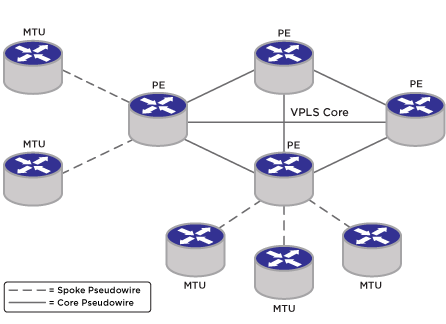H-VPLS Overview
VPLS requires a full mesh of pseudowires between all Provider Edge (PE) peers.
As MPLS is pushed to the edge of the network, this requirement presents a number of problems. One problem is the increased number of pseudowires required to service a large set of VPLS peers. In a full-mesh VPLS, pseudowires must be established between all VPLS peers across the core. Full-mesh networks do not scale well due to the number pseudowires that are required, which is p(p-1), where p is the number of peer devices in the network. Hierarchical VPLS (H-VPLS) networks can dramatically increase network scalability by eliminating the p2 scaling problem.
In a hierarchical VPLS network, a spoke node (often a Multi-Tenant Unit—MTU) is only required to establish a pseudowire to a single core PE. Thus the number of pseudowires required in the provider's network is c(c-1) + s, where c is the number of core PE nodes and s is the number of spoke MTU edge devices. This is a significant reduction in the number of pseudowires that need to be established and maintained. For example, a 10-core PE network with 50 MTU devices per core PE requires almost 260,000 pseudowires using a full-mesh VPLS design. A hierarchical VPLS design requires only 590 pseudowires.
An example H-VPLS network is shown in Example H-VPLS Network.

H-VPLS spokes allow VPLS domains to be constructed hierarchically in a partial-mesh or hub-and-spoke configuration. This is useful for increasing the scaling of VPLS domains that can be supported. Within the context of H-VPLS, a spoke is a VPLS connection between two VPLS peers. Typically, one spoke node provides connectivity to the customer VLAN or customer service while its peer, a core node, provides repeater connectivity to other VPLS peers.
The pseudowire hierarchy must be known because the forwarding rules for spoke and core pseudowires are different. Flood traffic received on a core pseudowire from another full-mesh core PE must not be transmitted over other core pseudowires to other PEs. However, flood traffic received on a core pseudowire is transmitted on all spoke pseudowires in the VPLS. Unlike core pseudowires in a full-mesh VPLS, flood traffic received on a spoke pseudowire must be transmitted on all other pseudowires in the VPLS, including pseudowires to other core PEs.
H-VPLS introduces the definition of a pseudowire type. In previous ExtremeXOS releases, only core peers were supported in an interconnected full-mesh configuration. Therefore, all pseudowires were considered to be of the type core. A new spoke pseudowire type is introduced and is highlighted in Example H-VPLS Network with Redundant Spokes. A VPLS core node that has multiple spoke pseudowires but no configured core pseudowires is informally referred to as a hub.

